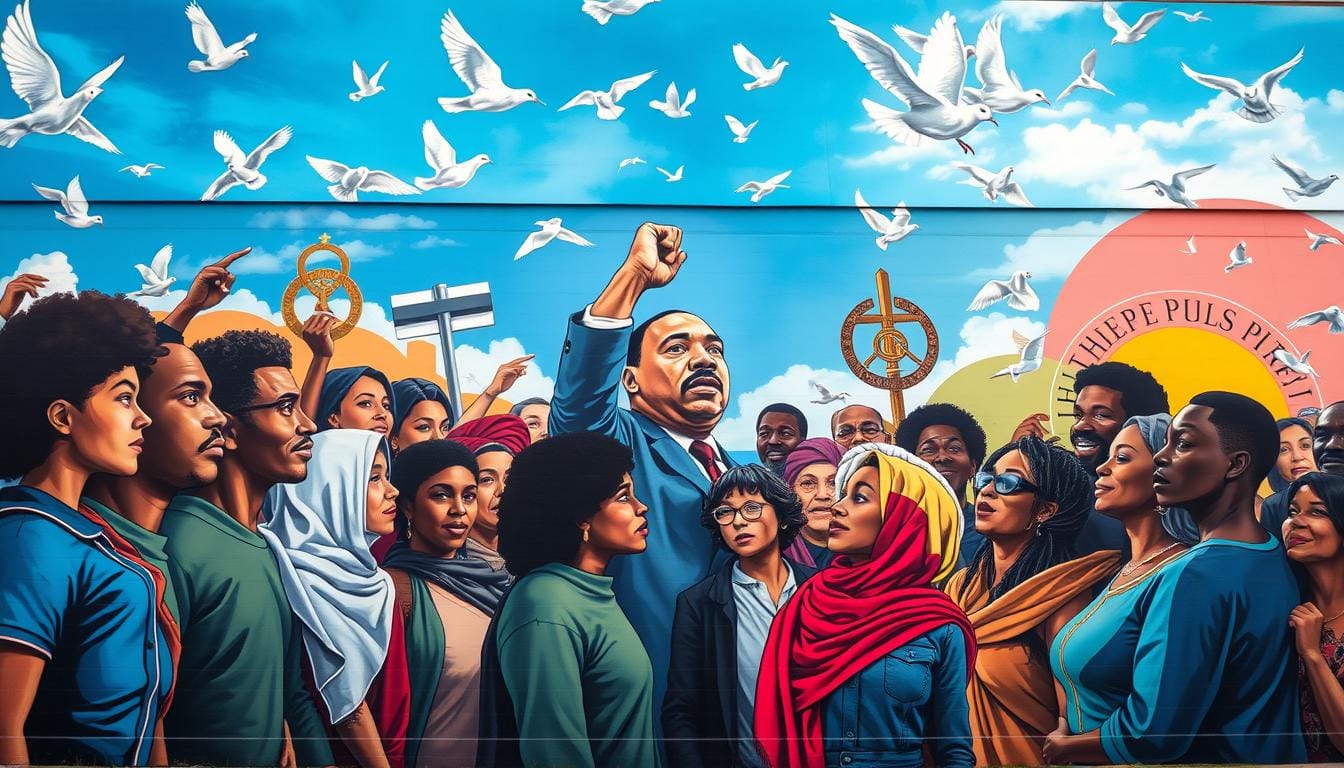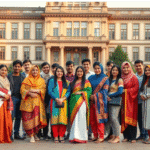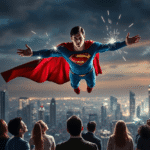Table of Contents
Did you know Dr. Martin Luther King Jr. led the Montgomery Bus Boycott at 26? It was a huge success1. This was just the start of his big impact on civil rights. On the third Monday of January, we celebrate Dr. Martin Luther King Jr. Day. We honor his achievements and remember his lasting legacy2.

Dr. King was born on January 15, 1929, in Atlanta, Georgia. He fought racial inequality with nonviolent resistance1. His leadership in the Montgomery Bus Boycott, lasting over a year, ended in 1956 with a court ruling against segregation1.
The importance of MLK Day goes beyond just a holiday. It’s a call to keep fighting for justice and equality in our society.
Introduction: The Importance of Dr. Martin Luther King Jr. Day
The significance of MLK Day is more than just a day off. It’s a time to remember Dr. Martin Luther King Jr.’s fight for equality. It’s celebrated on the third Monday of January, becoming a federal holiday in 198334. This day shows our hope for a fairer society.
People started asking for a national holiday right after Dr. King’s death in 1968. Their efforts led to the 1983 bill’s approval3. By 2006, it was known as the biggest petition in U.S. history for a cause4.
Before it was a federal holiday, many places celebrated on January 15th, Dr. King’s birthday3. This shows how important Dr. Martin Luther King Jr. Day is to Americans, fueled by the fight for civil rights.
Also, Affirmative Action Plans (AAPs) were created to ensure equal opportunities. Companies working with the U.S. government must follow these plans to avoid discrimination3. This day highlights the ongoing battle against unfair hiring and pay practices, mainly affecting Black Americans.

The celebration of Dr. Martin Luther King Jr. Day pushes for real change in the workplace. Research shows diverse teams are more creative and solve problems better3. So, honoring this day each year is a tribute to Dr. King’s dream and a call to action for inclusivity.
| Year | Event |
|---|---|
| 1968 | Assassination of Martin Luther King Jr.; call for a national holiday began |
| 1970-1983 | States and cities independently celebrate Jan 15th, Dr. King’s birthday |
| 1983 | Bill passed to create Martin Luther King Jr. Day as a national holiday |
| January 20, 1986 | First official observance of Martin Luther King Jr. Day |
| 2000 | Official observance of Martin Luther King Jr. Day by all states |
The Early Life of Martin Luther King Jr.
Martin Luther King Jr. was born as Michael King Jr. on January 15, 1929, in Atlanta, Georgia. This was during the Great Depression5. His father, Martin Luther King Sr., named him after himself at first. Later, after a trip to Germany, King Sr. changed both their names to honor Martin Luther6.

Birth and Family Background
Martin Luther King Jr.’s family background was key in shaping him. He grew up in a religious home, with his father being a minister and his mother a devoted churchgoer. Despite his father’s modest salary, the family was comfortable, meeting all their needs5. Their community was peaceful, with most people being deeply religious5.
His father left home at 18, after seeing the harsh realities of plantation life. He later finished his education at Morehouse College5. These experiences taught King Jr. about equality and justice early on.
Educational Journey
King attended Atlanta’s public schools and then Atlanta University Laboratory High School for two years. He moved to Booker T. Washington High School5. At 15, he entered Morehouse College, graduating in 1948 with a Sociology degree6.
He then went to Crozer Theological Seminary for three years, earning his Bachelor of Divinity in 19516. It was during his time at Crozer that he became interested in Gandhi’s nonviolent philosophy6. King also earned a Ph.D. in Systematic Theology from Boston University in 19556.
Throughout his education, King showed a strong commitment to social activism. His upbringing in a religious, average-income community instilled in him values of faith, equality, and justice5.
| Early Life Aspect | Details |
|---|---|
| Birth Name | Michael King Jr. (later changed to Martin Luther King Jr.)6 |
| Date of Birth | January 15, 19296 |
| Community | Religious with average income, minimal crime5 |
| Father’s Education | Completed education at Morehouse College5 |
| College Entry Age | 15 years old6 |
| Academic Degrees | Sociology (Morehouse), Divinity (Crozer), Ph.D. in Systematic Theology (Boston University)6 |
The Civil Rights Movement and Dr. King’s Leadership
The civil rights movement made huge strides thanks to Dr. King’s leadership. He started with the Montgomery Bus Boycott, lasting 381 days. This effort helped make racial segregation illegal78. Dr. King also co-founded the Southern Christian Leadership Conference (SCLC) in 1957. His goal was to use churches to organize peaceful protests against racism9
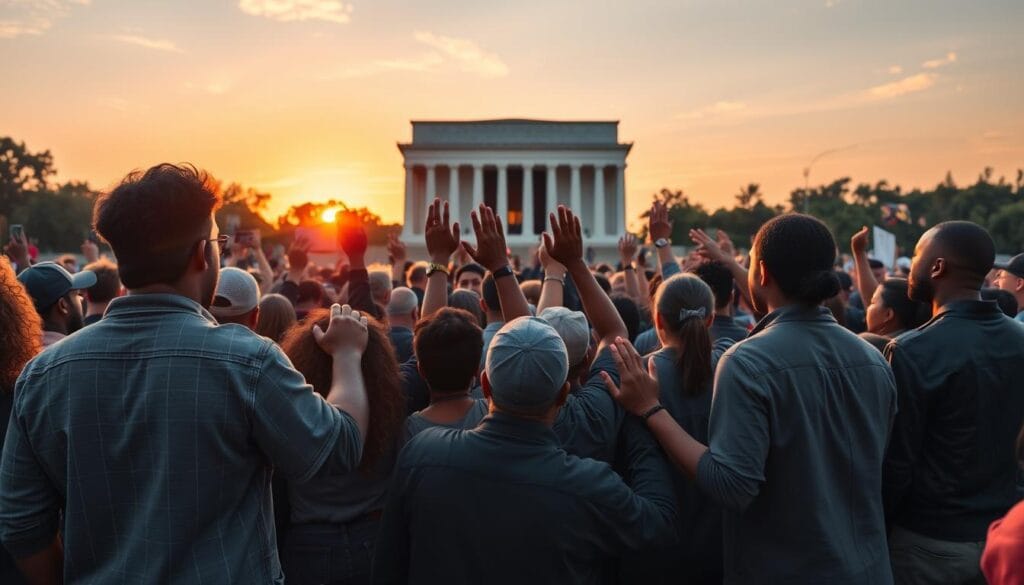
The SCLC led many important campaigns. For example, the 1963 Birmingham campaign drew national attention. It showed the need for change after police violence9. The March on Washington for Jobs and Freedom in 1963 was a key moment. Dr. King’s “I Have a Dream” speech made it unforgettable78. The Voting Rights Act of 1965 was a major victory after the Selma-to-Montgomery march78. Dr. King’s work earned him the Nobel Peace Prize in 1964, at just 35 years old798. He also received the Presidential Medal of Freedom and the Congressional Gold Medal after his death7. Dr. King’s leadership still inspires today. MLK Day is a time to remember and act. His work shows that fighting for equality never stops. The Civil Rights Act of 1964 and other successes show that change is possible through nonviolence and justice798. For more information, visit Dr. King’s legacy.
I Have a Dream: The March on Washington
The March on Washington for Jobs and Freedom happened on August 28, 1963. It was a key moment in the civil rights movement. Over 250,000 people gathered at the Lincoln Memorial to hear Martin Luther King Jr. deliver his famous “I Have a Dream” speech1011.
This huge gathering was one of the largest rallies for human rights in U.S. history. It helped push through civil rights legislation.
The Historical Context
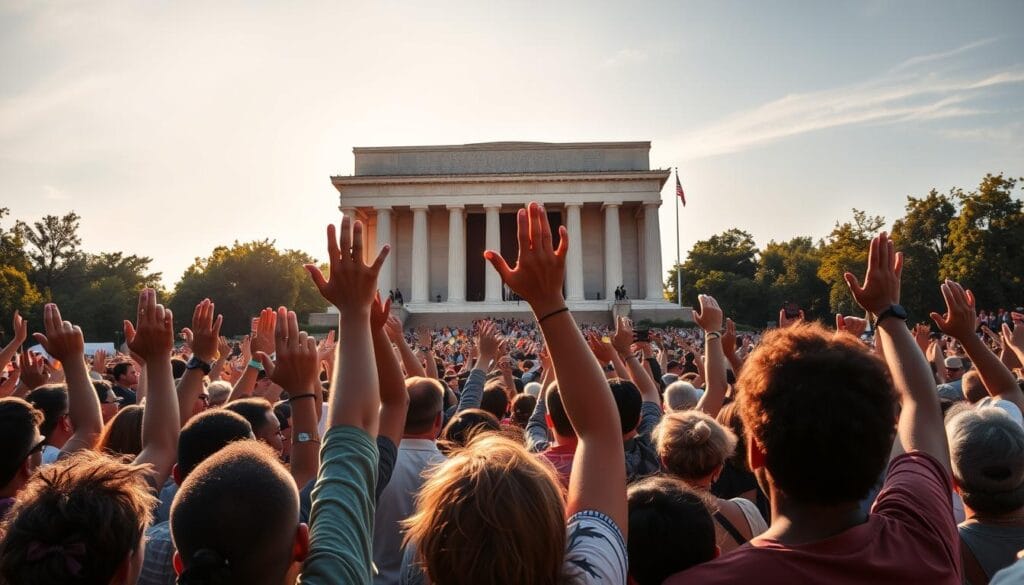
The March on Washington was planned since 1941 but was delayed for political reasons11. It happened on August 28, 1963, after 20 years of work by civil rights leaders. They formed a coalition called “The Big Six”11.
This movement showed the ongoing fight for racial equality. It highlighted the economic struggles faced by African Americans a century after the Emancipation Proclamation10. About 50% of African Americans lived below the poverty line in the early 1960s. Their unemployment rate was much higher than that of white Americans10.
Key Points of the Speech
Dr. Martin Luther King Jr.’s “I Have a Dream” speech was meant to be four minutes but lasted 16 minutes11. It captivated over 250,000 people. His words painted a picture of his vision for racial and social justice.
King talked about the broken promises of equality to African Americans. He compared it to a “check” of justice marked “insufficient funds,” showing the ongoing inequalities10.
He also spoke about racial segregation and police brutality. King said racial segregation had crippled African American lives, leading to widespread poverty10. He stressed the need to address police brutality and the lack of Black voter registration, noting only about 5% of eligible Black voters in the South were registered in 196310.
The impact of King’s dream was deep. It envisioned a future where justice would overcome racial barriers. His words echoed the need for change, saying there would be “no rest nor tranquility in America” until all citizens were equal10. The speech helped pass the Civil Rights Act of 1964 and the Voting Rights Act of 196511.
Dr. King’s Legacy in Modern Times
Dr. King’s legacy lives on in today’s civil rights movements. He inspires a new generation of activists. His commitment to peaceful protest and nonviolence guides us towards equality and justice.
Impact on Modern Civil Rights Movements
Dr. Martin Luther King Jr. was key in shaping the civil rights movement. His influence still guides modern efforts for equality. In 2024, thousands are expected to volunteer on Dr. King’s Day12.
Events celebrating MLK Jr. Day boost discussions on social justice in schools by 25%12. Seattle’s 42nd Annual MLK Day Rally and March honors Dr. King’s work and tackles today’s issues13.
These events show Dr. King’s lasting impact on civil rights and community unity.
Enduring Message of Peaceful Protest
Dr. King’s focus on peaceful protest is still influential today. His nonviolent resistance is a powerful way to fight for justice without violence. Community events, like the one at Renton Ikea Performing Arts Center, show his legacy in action13.
MLK Day education increases awareness and engagement, reaching thousands12. This shows Dr. King’s peaceful protest message is still driving activism today. His teachings inspire movements for justice and equality, based on compassion and nonviolence.
Memorable Martin Luther King Jr. Quotes
Dr. Martin Luther King Jr.’s words are a beacon of hope and determination. His quotes, like “Injustice anywhere is a threat to justice everywhere,” inspire us deeply. They guide us in our quest for justice and equality.
At the March on Washington in 1963, Dr. King gave his famous “I Have A Dream” speech. Over 250,000 people listened as he dreamed of a future where children are judged by their character, not skin color14. This dream continues to inspire us today.
Dr. King’s writing is powerful, as seen in his “Letter from Birmingham Jail” in 1963. He also gave a Nobel Peace Prize acceptance speech in 1964, filled with inspirational quotes14.
In “Strength to Love,” published in 1963, Dr. King shares his philosophical strength. He says, “Darkness cannot drive out darkness; only light can do that. Hate cannot drive out hate; only love can do that.” These quotes reflect on love and resilience14.
Dr. King often spoke about faith, community, and justice. For example, he said, “We must live together as brothers or perish together as fools”. His words guide us in personal conduct and societal justice15.
Dr. King’s Work Beyond Civil Rights
Dr. Martin Luther King Jr. did more than fight for civil rights. He also pushed for economic justice and labor rights. He saw how racial equality and economic fairness were linked. His support for the sanitation workers’ strike in Memphis in 1968 shows his commitment to these causes.
The strike was about fair wages and safe work conditions. It shows Dr. King’s dedication to economic justice and labor rights.
Economic Justice and Labor Rights
Dr. King fought for economic justice alongside civil rights. He thought racial equality needed economic fairness too. During the 1968 Memphis sanitation workers’ strike, he stood strong with the workers.
He supported their fight for better wages and working conditions16. This showed his ongoing fight for economic justice and labor rights7. The strike was about more than money; it was about human dignity and rights.
Stance on the Vietnam War
Dr. King also spoke out against the Vietnam War. In his “Beyond Vietnam” speech at Riverside Church in 1967, he clearly stated his opposition8. He criticized the U.S. for its role in the war.
He argued against the war’s moral and economic costs. Dr. King saw peace and justice as connected. He believed solving systemic oppression at home and abroad was key to progress.
Dr. King’s work on economic justice, labor rights, and the Vietnam War shows his wide vision. His legacy continues to inspire efforts for justice and equality today.
Significance of MLK Day in Contemporary Society
The Importance of Dr. Martin Luther King Jr. Day is felt deeply today. It’s celebrated on January 15 as a federal holiday17. It’s more than just a day off; it’s a time for reflection and action. It reminds us of Dr. King’s fight for justice.
It’s observed on the third Monday in January, close to Dr. King’s birthday. This makes it even more meaningful18.
Across the nation, MLK Day is filled with events and activities. In King County, thousands help local non-profits through service projects17. The Seattle MLK Coalition hosts events like community dialogues and youth gatherings to inspire justice17.
The celebration goes beyond local events. The Northwest African American Museum offers free access to music and motivational speakers. This shows the MLK Day relevance in preserving culture and education17. The University of Washington Tacoma’s MLK Unity Breakfast honors community service with the Dream Awards, highlighting the Importance of Dr. Martin Luther King Jr. Day17.
In Tacoma, the City hosts a birthday celebration with local speakers and performers. The Washington State Historical Society and Tacoma Arts Live also host events. These activities honor Dr. King and promote social justice.
Since 1983, the federal government has observed this day. But it wasn’t until 2000 that all 50 states did too18. This shows how Dr. King’s work is now recognized nationwide. The holiday’s observance across the U.S. shows its ongoing relevance in fighting racism and inequality.
The day reminds us of our duty to carry on Dr. King’s work. By joining service projects, dialogues, and educational efforts, we honor his legacy. This ensures the Importance of Dr. Martin Luther King Jr. Day stays important in our society.
Commemorating MLK Day: Nationwide Events and Activities
Dr. Martin Luther King Jr. Day is a big event in the United States. It’s celebrated on the third Monday of January. It honors Dr. King’s legacy through community events and education.
Local and National Observances
Across the country, MLK Day events remember Dr. King’s life and mission. In New York City and New Jersey, there are fifteen events from January 19 to 20. These include runs, discussions, and concerts at famous places like the Brooklyn Academy of Music and Apollo Theater. The Brooklyn Children’s Museum even celebrates for two days19.
In the Bay Area, there’s a week-long festival from January 9 to 15. It features parades, film festivals, and wellness activities. Highlights include the MLK Noontime Concerts on January 9 and 16, and the Martin Luther King Jr. Weekend of Service from January 12 to 1520.
Educational Programs and Initiatives
Educational programs on MLK Day are key to learning about civil rights history. In New Jersey, workshops run from January 18 to 20. They offer activities like coastal clean-ups and panel discussions19. In the Bay Area, the OUSD MLK Oratorical Fest lets students share Dr. King’s teachings20.
The Black & Brown Comix Arts Festival (BCAF) Children’s Day is free on January 13. And on January 15, many museums offer free admission. These efforts make education and culture accessible to everyone20. They ensure Dr. King’s message inspires future generations to fight for equality and justice.
The Continuing Fight for Equality and Justice
Dr. King’s fight for equality and justice is still important today. Martin Luther King Jr. Day reminds us of the ongoing battle against racial and social injustices.
How Dr. King’s Vision Lives On
Dr. King’s dream of a fair society inspires today’s movements. The Montgomery Bus Boycott in 1955-1956 was a key moment in the Civil Rights Movement21. The March on Washington in 1963 showed the nation’s desire for change21.
Today, movements like Black Lives Matter carry on Dr. King’s legacy of peaceful protest22. His dream of a society where everyone is judged by character, not skin color, still motivates us23.
Current Civil Rights Challenges
We still face many civil rights issues today, like racial inequality and economic gaps. In 1966, many Americans didn’t support Dr. King, showing the racial tensions of his time23. But today, 81% of Americans see his positive impact23.
Despite progress, challenges like voter suppression and police brutality show the fight is not over. Modern activism, inspired by Dr. King’s nonviolence, keeps his mission alive22.
| Civil Rights Challenge | Impact |
|---|---|
| Systemic Racial Inequality | Continues to affect access to education, healthcare, and employment opportunities. |
| Economic Disparities | Result in unequal wealth distribution, affecting minority communities disproportionately. |
| Social Injustices | Manifest as voter suppression and police brutality, creating hurdles for achieving true equality. |
Dr. Martin Luther King Jr. Day: Reflecting on Our Progress
Every third Monday in January, we come together to reflect on civil rights progress and what still needs work24. In 1983, Martin Luther King Jr. Day became a federal holiday. It’s a time to honor a leader who changed America’s civil rights journey24.
Since Dr. King’s death in 1968, we’ve made big strides. Laws like the Civil Rights Act of 1964 and the Voting Rights Act of 1965 have helped fight racial inequality24. Dr. King once said, “injustice anywhere is a threat to justice everywhere.” This reminds us to keep fighting for fairness24.
Institutions like Penn State are making strides in diversity and inclusion. Today, 21% of students come from underrepresented groups, a big jump from 1965’s 1.4% African American students25. Also, nearly half of undergrads are women25.
Recently, 6,000 Penn State folks joined panels on diversity, equity, and inclusion25. These efforts show progress but highlight the ongoing need for vigilance. Safety concerns for Black males and rising racism are still issues25.
Across the country, people celebrate Martin Luther King Jr. Day with volunteer work and local events. These actions reflect Dr. King’s belief in service. They help us remember our civil rights history and the challenges we face today24. By participating, we show the importance of civil rights progress and the ongoing quest for equality and justice for all.
Conclusion
Dr. Martin Luther King Jr. Day is more than just a day to remember. It’s a call to action and advocacy. We reflect on Dr. King’s legacy and strive to live by his ideals every day. Dr. King, born on January 15, 1929, changed America with his movement26.
His win of the Nobel Peace Prize at 35 still inspires us to fight for justice and equality26. His work led to the Civil Rights Act of 1964 and the Voting Rights Act of 1965. These laws banned discrimination and protected voting rights, showing Dr. King’s lasting impact27.
On MLK Day, we join in community service and education. We help in shelters, clean up, and give out food. These actions show we’re committed to Dr. King’s dream of a fair society26. By doing so, we honor Dr. King and work towards a future where everyone has equality and justice.
FAQ
What is the significance of Dr. Martin Luther King Jr. Day?
Dr. Martin Luther King Jr. Day is on the third Monday of January. It honors the life and work of a key civil rights leader. It’s a day to think about how far we’ve come and what we still need to achieve.
Can you provide a brief overview of Dr. Martin Luther King Jr.’s early life?
Dr. Martin Luther King Jr. was born on January 15, 1929. He was named Michael King Jr. but later changed to Martin Luther. His family taught him about equality and justice from a young age.
How did Dr. King become involved in the civil rights movement?
Dr. King became famous during the Montgomery Bus Boycott. He showed he could lead through tough times. He also co-founded the Southern Christian Leadership Conference to fight for civil rights.
What was the significance of the “I Have a Dream” speech?
The “I Have a Dream” speech was given during the March on Washington. It was a key moment in civil rights history. Dr. King’s words called for racial and economic justice, inspiring a big change in laws.
How does Dr. King’s legacy influence modern civil rights movements?
Dr. King’s ideas and actions still inspire today’s civil rights movements. His belief in nonviolence and civil disobedience guides activists. His speeches and teachings help organizations fight for fairness and justice.
Can you share some memorable quotes by Dr. Martin Luther King Jr.?
Sure! Dr. King said, “Injustice anywhere is a threat to justice everywhere.” He also said, “I have decided to stick with love…Hate is too great a burden to bear.” His words inspire hope and make us think about fairness and ethics.
What was Dr. King’s work on economic justice and labor rights?
Dr. King fought for racial equality and also for economic justice and labor rights. He supported the sanitation workers’ strike in Memphis. He believed everyone should have fair wages and good working conditions.
Why is Dr. Martin Luther King Jr. Day relevant in today’s society?
MLK Day reminds us of the ongoing fight against racism and unfairness. It encourages us to think deeply and get involved. It’s a call to keep working towards the fairness Dr. King believed in.
How is MLK Day commemorated across the United States?
MLK Day is celebrated with parades, community service, and educational programs. These events honor Dr. King’s life, teach about civil rights history, and bring people together.
What are the current challenges in the fight for equality and justice?
Despite progress, we still face racial, economic, and social justice challenges. Movements for racial equity and reform show Dr. King’s vision is still important today.
How does Dr. Martin Luther King Jr. Day help us reflect on societal progress?
MLK Day helps us see how far we’ve come and what we still need to do. It’s a chance to measure our progress in civil rights and what we must achieve to reach Dr. King’s dream of equality and justice for all.
